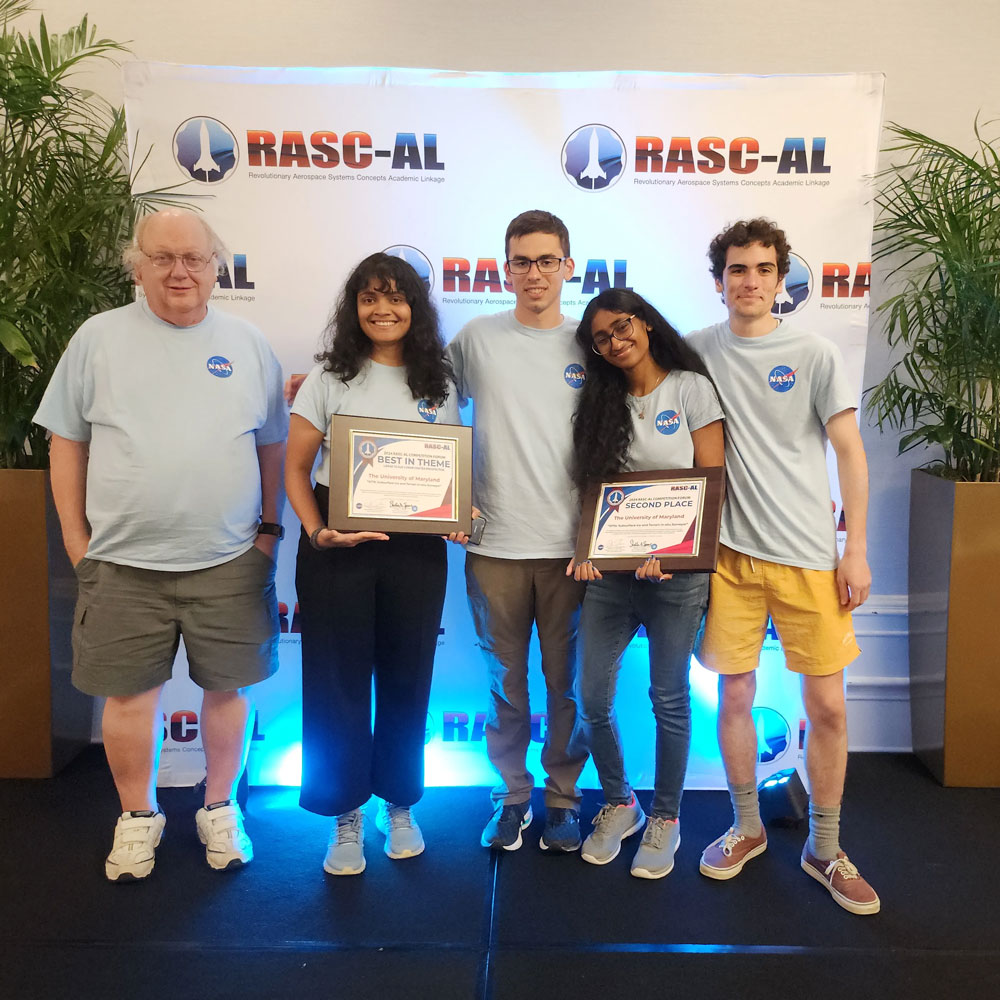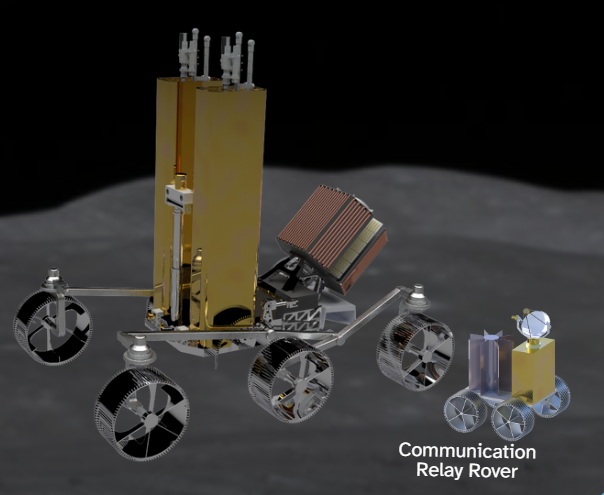News Story
Designing for Moon Mission

From left to right: Faculty advisor, Professor David Akin and aerospace engineering seniors Kruti Bhingradiya, Robert Fink, Sneha Sunilkumar, and Matias Calderon. (Photo courtesy of NASA/NIA)
A University of Maryland (UMD) team took second place overall and best in theme at the 2024 NASA Revolutionary Aerospace Systems Concepts – Academic Linkage (RASC-AL) Competition held this summer in Cocoa Beach, Flor.
As NASA aims to return humans to the moon, and pioneer space exploration further into our solar system, competitions like RASC-AL challenge collegiate teams to design innovative new concepts to address space exploration challenges.
This year’s competition asked students to design a project around one of four themes: long duration mars simulation at the moon, sustained lunar evolution, AI-powered self-replicating probes – an evolutionary approach, and large-scale lunar crater prospector.
The UMD team tackled the ‘Large-Scale Lunar Crater Prospector’ category with their project SITIS— Subsurface Ice and Terrain In-situ Surveyor—an uncrewed rover (pictured at right)  designed for a one-year mission to explore permanently shadowed regions of the lunar south-pole (where the average temperature is -250°C) and characterize water ice resources and other volatiles.
designed for a one-year mission to explore permanently shadowed regions of the lunar south-pole (where the average temperature is -250°C) and characterize water ice resources and other volatiles.
Going beyond the basic aim of the challenge, to design a single rover, the team also incorporated a novel approach to communications that allowed their mission vehicle to remain in continuous contact with earth.
“We designed our mission to have a small communication relay rover at the rim of our chosen location, the Sverdrup-Henson crater, which would directly align itself with Earth,” explained Kruti Bhingradiya ’24, team lead. “As Earth moves, this rover would move around the rim of the crater and find the best ‘parking location’ to have a direct line of sight to Earth.”
Beyond designing two rovers, the team took an integrated approach to their mission design so they could get the most ‘science to dollar ratio,’ designing multiple systems that maximized their resources. Their primary rover featured a nuclear-powered dual loop power system—designed by team member Nazifa Mahmud—that both ran the rover and provided a heat source to keep onboard components warm. The team also devised, and modeled, an approach to evaluating the rover’s path planning to maximize the number of ice points it could explore, thus maximizing its experimental output.
“We really wanted to design a mission that would spend the least energy, but cover more ice points, and two different craters, while operating in the permanently shadowed region of the moon,” said Bhingradiya. “From there, we took the systems engineering perspective, and the mission planning perspective, and drove that down into the technical aspects of the mission.”
The RASC-AL competition was the culmination of a year’s work by students in the department’s capstone courses ENAE 483/484 taught by Professor David Akin.
As part of their preparation, and capstone coursework, the team also participated in the Clark School’s inaugural Capstone Design Expo held this spring, which showcased senior design projects from across several engineering departments.
“The Capstone Design Expo was the first time our team presented our poster,” said Bhingradiya. “It was a turning point for us. We realized how much work we had actually accomplished, it helped us refine our presentation strategy, and getting placed really gave us a lot more confidence heading into competition!”
In its 23rd year, RASC-AL is one of NASA’s longest running higher education competitions. It is open to undergraduate and graduate students studying disciplines related to human exploration, including aerospace, bio-medical, electrical, and mechanical engineering, and life, physical, and computer sciences. RASC-AL projects allow students to incorporate their coursework into space exploration objectives in a team environment and help bridge strategic knowledge gaps associated with NASA’s vision.
Published June 25, 2024









